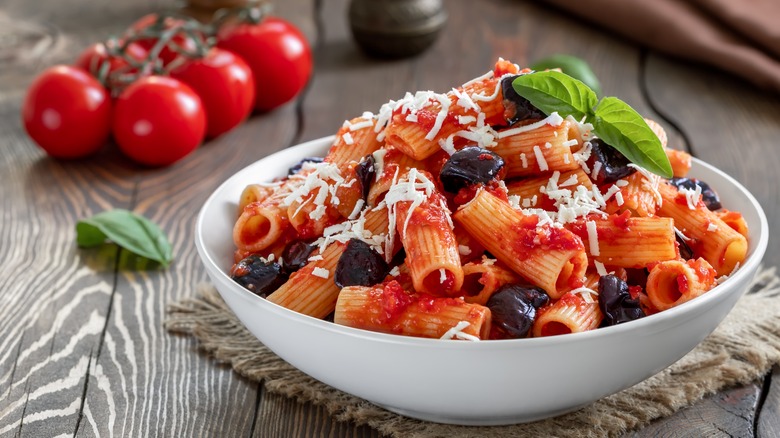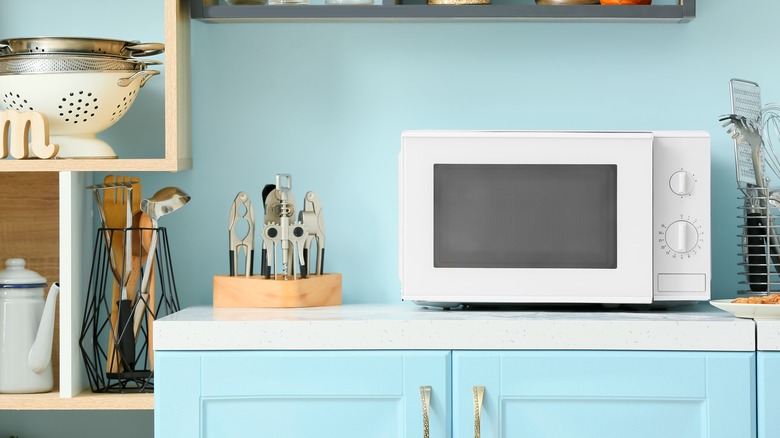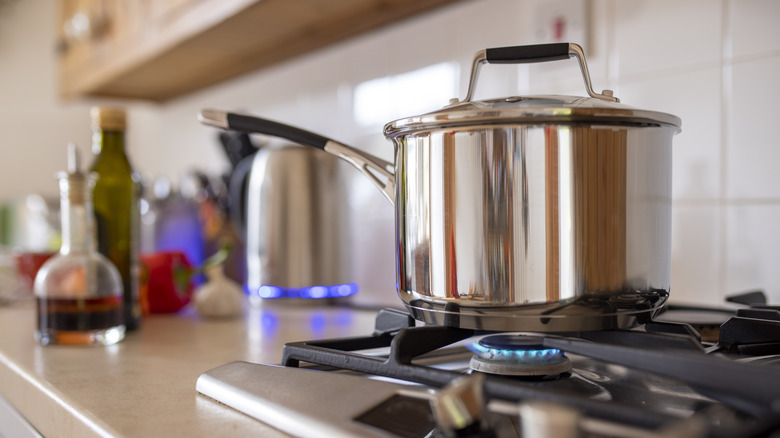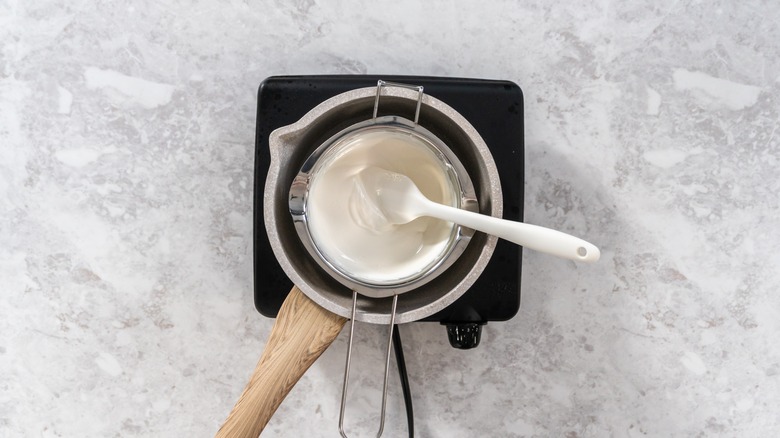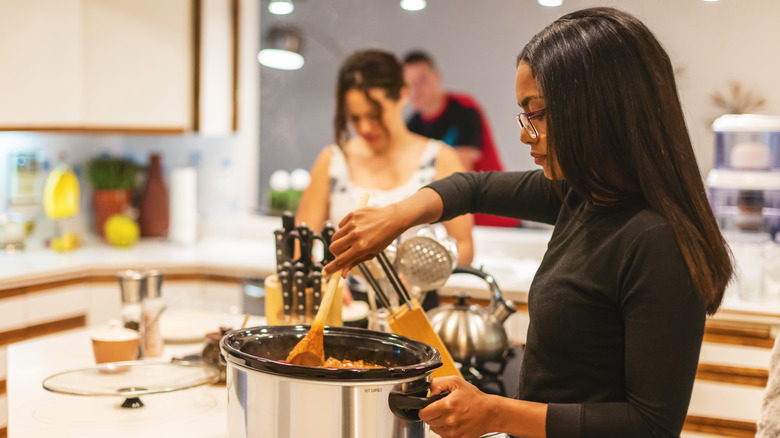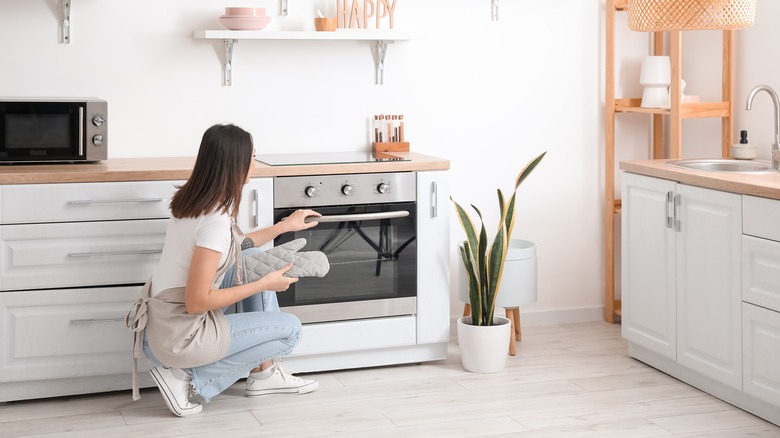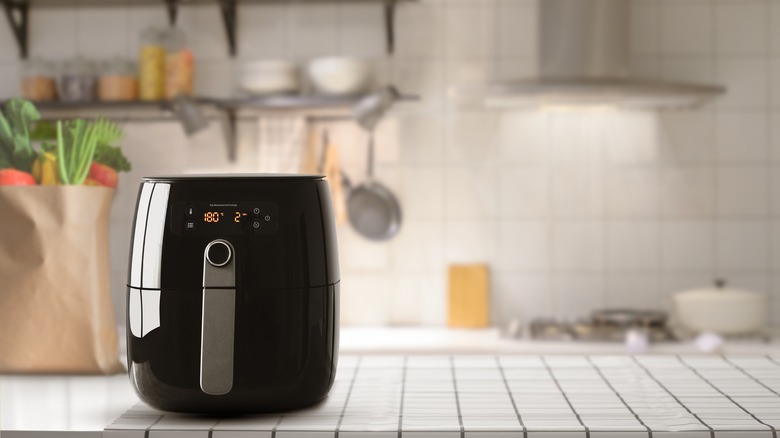The Best Ways To Reheat Leftover Pasta Sauce
For many households, pasta is a kitchen staple. And regardless of how you choose to cook it, many chefs, seasoned and novice, can agree — it's all in the sauce. Hearty marinara, creamy alfredo, or bright cacio e pepe are just some of our favorite ways to prepare penne, spaghetti, and beyond. But what do you do when you simply make too much pasta sauce?
Even if it was an ultra-delicious meal, we know the temptation to toss it in the garbage is there. After all, how does someone reheat pasta sauce without ruining the texture or flavor? It's an age-old question that we've decided to answer by using our own cooking knowledge and pasta resources across the web to assemble six of the best ways to do it.
Whether you're aiming for leftovers or creating a brand-new dish, you can check out the best ways to reheat pasta sauce ahead.
Pop it in the microwave
A tried and true method for many leftovers, the microwave rarely fails when it comes to heating up food from last night's dinner. To use one of the quicker and easier ways to reinvigorate pasta sauce, you should first place the sauce in a microwave-safe container like a glass mason jar or a ceramic bowl. From there, you can add around two tablespoons of water and gently stir, then place a lid on top (be sure not to seal it tightly).
Once you've set your microwave on the high setting, you can heat it up in increments of 30 seconds. After the first 30, you'll want to give it a light stir, then continue until the sauce has reached an internal temperature of 175 degrees Fahrenheit (74 degrees Celsius).
This method is fast and easy to do, especially if you're in a bind and need to eat something quick. However, the microwave does have its cons, too: This option may not be the best for heavier cream-based sauces like vodka sauce which often separate once they've been reheated. Additionally, you'll need to ensure you're using a microwave-safe container. Per CNN, plastic containers can contain chemicals that, once heated, seep into your foods. And don't forget the lid — tomato-based sauces are notorious for exploding and making a mess inside the microwave if they're not covered.
Use a stovetop for a quick simmer
The stovetop is our personal pick when it comes to reheating pasta sauce. It requires a bit more effort than throwing it in the microwave, but in our opinion, it's worth it. This is the best method for tomato-based sauces like marinara or bolognese. This is because they're a bit simpler to reheat and are less likely to split or burn in comparison to cream sauces, which require more gentle reheating methods.
For the best results, you'll want to use a small saucepan or pot on medium-high heat. Once your sauce is at a boil, reduce the heat to low and simmer for 10 minutes without a lid. It's ready as soon as you've noticed that the sauce has thickened up a little. If your sauce ends up being a little too thick, you can add in some water, broth, or even skim milk to thin it out.
We like this option because it's also pretty low maintenance, though it does take a little bit longer than the microwave. At maximum, you may be waiting around 15 minutes for your sauce to be thoroughly heated, but it's a great method if you want to make sure you're keeping the flavor and texture intact.
Whisk it over a double boiler
We've covered options that aren't cream sauce-friendly, so how are you supposed to reheat alfredo or classic white sauce? Don't worry, we've got you covered with the double boiler method. The aim of double boiling is to slowly heat a bowl that's inside of a larger pot using steam. You don't need to purchase a double boiler specifically for this option. Instead, all you need is a pot deep and wide enough to rest a stainless steel or glass mixing bowl on top. Once you've got those items, you're set.
Firstly, you'll want to add two to three inches of water into the larger pot. Once it's boiling, you can reduce the heat to low and place your sauce in the mixing bowl, setting the bowl on top of the pot (the water should be at a simmer at this point). You should whisk the sauce frequently in 15-second increments for around five minutes. Once the sauce reaches a temperature of 165 degrees Fahrenheit, you can remove it, but continue stirring vigorously. Once it's cooled to 150 degrees Fahrenheit, it's ready to be mixed in with your noodles of choice.
This is probably your best bet for cream sauces. It doesn't take too long, but it does need more kitchen equipment than other methods on our list. You also need to keep an eye on both the temperature and the texture to ensure you don't accidentally burn your sauce.
Amplify flavors in a slow cooker
We'll admit that this isn't the most efficient technique, but it's certainly appealing, especially if you already have a slow cooker on hand. A slow cooker will use moist heat to cook food over a lengthy period of time. Slow cookers are great for preparing food ahead of time in large quantities or giving a meal a second life.
You can reheat pasta sauce in a slow cooker for around two to three hours on low setting, stirring occasionally. Adding a bit of water or broth to it prior to cooking helps prevent over-thickening. You can serve it up whenever the time is up or it's warm enough to eat.
This is a fun reheating method if you're looking to make a brand-new meal out of your sauce. You can add new seasonings in — for example, you can kick up the heat with red chili flakes to make your tomato sauce more akin to a spicy arrabbiata and use it on chicken parmesan heroes. That being said, it'll obviously take much longer than any other option, so it's not good if you're in a hurry.
Use a conventional oven
While we recommend keeping your pasta and sauce separate when reheating, if you're looking to heat up a lasagna or baked ziti, the oven is a good technique. You can pop a piece of aluminum foil over the dish and put it in the oven at 350 degrees Fahrenheit for 10 to 30 minutes. You should check it every 5 to 10 minutes to ensure it's not burning.
Another option, if you're reheating sauce by itself, is to add a little bit of water prior to reheating it in the oven. This is because some sauces can dry out once they've made their way into the refrigerator. Adding liquid will help thin things out without taking too much away from the overall taste profile.
The primary drawback here is that you can't monitor the sauce as closely. If you're constantly opening the oven, you're likely letting heat out, which means it'll take even longer to cook. It becomes a bit of a guessing game, so we recommend other methods for reheating pasta sauce on its own. This method is probably the best for dishes in which the pasta and sauce are already mixed together.
Use an air fryer in a pinch
Air fryers have become all the rage in the culinary world, namely for their ability to cook and reheat up anything from chicken to pizza. Enter the question: Can pasta sauce be reheated in an air fryer?
Short answer: Yes, but it's probably not your best bet. Saucy foods aren't the best options for air fryers since the appliances heat food via hot air, resulting in a crusty external layer. Portions of lasagna and baked ziti may be good candidates, but marinara sauce or — yikes — cream sauce could be nightmarish. If you do choose this method, you may have to scrape off the crunchy surface or stir it back into the sauce.
That being said, if you have some leftover meatballs to go with your sauce, the air fryer could be a good option. You can cook them at 350 degrees Fahrenheit for three to five minutes. After that, you can reintroduce them to the heated sauce for a super yummy meal.
